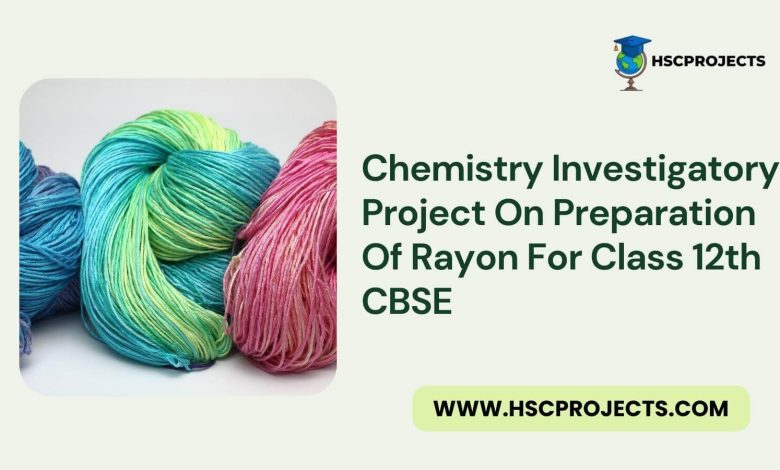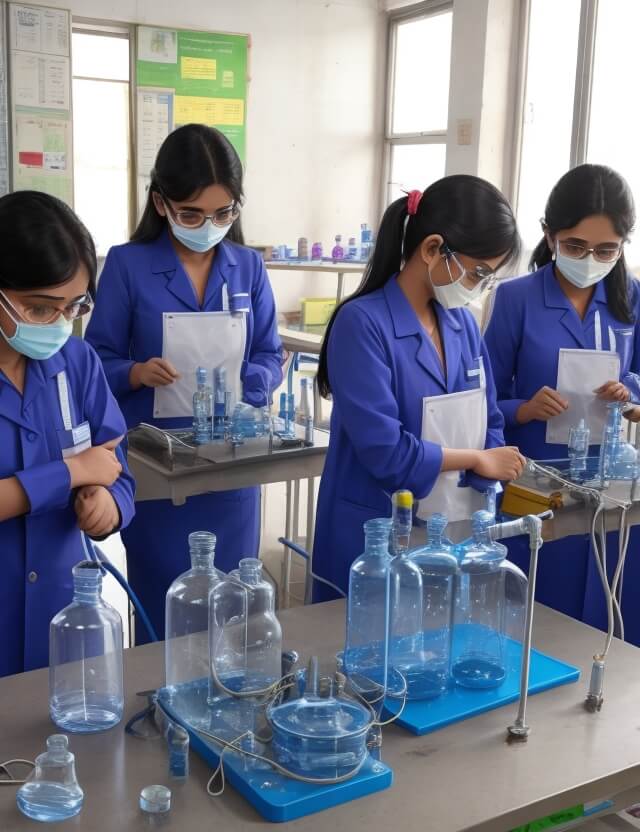
Chemistry Investigatory Project On Preparation Of Rayon For Class 12th CBSE
Introduction
Rayon, often dubbed as the “artificial silk,” emerges as an exceptional and highly adaptable synthetic fiber that has left an enduring imprint on the landscape of textiles. Originating from natural cellulose, primarily sourced from wood pulp, rayon possesses a unique blend of characteristics that effortlessly bridge the divide between natural counterparts like cotton and silk, and their synthetic cousins such as polyester and nylon. This versatile material plays an instrumental role not only within the textile realm but also in various other domains. In this extensive investigative project, we embark on a profound exploration of rayon, unveiling the intricacies of its production, dissecting the chemical processes at play, and surveying the extensive landscape of its applications.

Objectives
- Grasping the Craft of Rayon Preparation: Our foremost objective is to acquire an in-depth and holistic understanding of the multifaceted process that underpins the creation of rayon.
- Investigating the Alchemy of Chemical Reactions: Our secondary aim is to undertake a rigorous examination of the chemical reactions and transformations that occur during the birth of rayon.
- Evaluating Properties and Applications: Our ultimate goal is to meticulously assess the distinctive properties of rayon and embark on an exploration of its extensive range of applications across diverse industrial sectors.
Materials and Methods
Materials
- Cellulose Source: Derived from either wood pulp or cotton linters, serving as the foundational element of rayon.
- Sodium Hydroxide (NaOH): Employed to initiate the chemical transformations within the process, facilitating cellulose dissolution.
- Carbon Disulfide (CS2): An indispensable component for the formation of cellulose xanthate, a pivotal intermediate compound.
- Sulfuric Acid (H2SO4): Utilized at various stages for neutralization and chemical processing, ensuring the quality of the end product.
- Acetone: Facilitates the purification of rayon fibers, contributing to their final purity.
- Water: Deployed in multiple stages, primarily for dilution, rinsing, and solvent extraction, serving as a universal solvent.
- Glassware: Essential laboratory equipment, including flasks, beakers, and test tubes, ensuring precise measurements and reactions.
- Spatula: Used for meticulous measurements and the precise handling of chemicals, fostering accuracy.
- Thermometer: Monitors temperature fluctuations during reactions, ensuring controlled conditions.
- Distillation Setup: Employed for specific purification processes, guaranteeing the purity of rayon.
- Spinnerets: Vital for the extrusion process and fiber formation, shaping the foundation of rayon production.
Methods
Preparation of Viscose Solution:
a. Cellulose Dissolution: Commence by dissolving cellulose, sourced from wood pulp or cotton linters, in a mixture of sodium hydroxide (NaOH) and water. This initiates the conversion of cellulose into a soluble form.
b. Introduction of Carbon Disulfide: Introduce carbon disulfide (CS2) into the mixture, a pivotal addition that results in the formation of cellulose xanthate, a crucial intermediate compound.
c. Aging the Solution: Allow the solution to age for a specified duration, a critical step in achieving the desired viscosity, which directly influences the quality of the resulting rayon fibers.
Extrusion of Filaments :
a. Extrusion Process: Extrude the viscose solution through spinnerets, specialized devices designed for this purpose. The solution is skillfully forced through minute openings into a bath of dilute sulfuric acid (H2SO4).
b. Regeneration of Rayon: As the extruded filaments encounter the dilute sulfuric acid bath, the cellulose xanthate is regenerated, leading to the formation of cellulose fibers—the fundamental building blocks of rayon.
Acid Bath and Neutralization:
a. Acid Bath Immersion: Immerse the extruded filaments into an acid bath containing sulfuric acid (H2SO4), serving to neutralize any residual sodium hydroxide (NaOH) from earlier stages.
b. Thorough Rinsing: Following the acid bath, the rayon filaments undergo thorough rinsing with water to eliminate any remnants of chemicals, ensuring the purity of the final product.
Stretching and Drying a. Stretching Process: To enhance the strength and molecular alignment of the wet rayon fibers, they are subjected to a stretching process, optimizing their structural integrity.
b. Drying: Subsequent to stretching, the fibers are carefully dried, a critical step in preserving their form and functionality.
Cutting and Packaging a. Cutting: Once dried, the rayon undergoes precise cutting into the desired lengths, rendering it ready for an array of applications.
b. Packaging: The processed rayon is methodically packaged and readied for distribution across diverse industries, where it will contribute to a multitude of products and applications.
Chemical Reactions
The transformation of cellulose into rayon hinges on two pivotal chemical reactions:
- Formation of Cellulose Xanthate:Cellulose + NaOH + CS2 → Cellulose Xanthate
- Regeneration of Rayon from Cellulose Xanthate:Cellulose Xanthate + H2O → Cellulose (Rayon) + CS2 + NaOH
Properties of Rayon
Rayon boasts a remarkable array of properties, rendering it a favored choice across diverse industries:
- Soft and Comfortable: Rayon is renowned for its sumptuous softness and unparalleled comfort, establishing itself as a premier choice in clothing and textile production.
- Absorbent and Breathable: With its impressive moisture absorption capacity and inherent breathability, rayon offers comfort and adaptability in various climates and conditions.
- Aesthetic Resemblance: Rayon closely mirrors the appearance and texture of natural fibers like cotton and silk, bestowing it with a captivating visual and tactile appeal.
- Versatility: Rayon’s versatility knows no bounds, encompassing a multitude of applications spanning from elegant clothing to home textiles and essential industrial products.
- Color Retention: Rayon readily absorbs dyes, preserving vibrant and enduring colors, which is pivotal in fashion and textile industries for achieving striking aesthetics.
Applications
- Fashion: In the realm of fashion, rayon graces dresses, shirts, blouses, and innerwear, combining style with comfort in an elegant fusion.
- Home Textiles: Rayon’s softness and aesthetic charm make it a sought-after choice for bed linens, curtains, and upholstery, lending a touch of luxury to living spaces.
- Medical Textiles: In the medical field, rayon plays a pivotal role in the creation of surgical gowns, bandages, and medical dressings, offering functionality and maintaining rigorous hygiene standards.
- Industrial Use: Rayon’s strength and durability are indispensable in the manufacture of essential industrial products such as tire cords, conveyor belts, and fire hoses, where reliability is paramount.
- Art and Crafts: Even in the creative realm of art and crafts, rayon takes center stage, providing artists with a versatile and vibrant medium for embroidery and mixed-media art projects, fostering creativity.
Conclusion
In conclusion, the journey of rayon production is a meticulously choreographed transformation of cellulose into a versatile and invaluable synthetic fiber. A comprehensive understanding of its intricate processes and unique properties holds great significance, both in academic exploration and practical applications. Rayon’s ubiquitous presence across diverse industries, from fashion and textiles to manufacturing, underscores its enduring importance within the textile landscape. As we navigate its multifaceted dimensions, rayon stands as an iconic material, enriching our world with its softness, versatility, and timeless allure.

Certificate of Completion
[Student’s Name][Class/Grade Level]This is to certify that I, [Student’s Name], a [Class/Grade Level] student, have successfully completed the project on “Preparation Of Rayon For Class 12th CBSE.” The project explores the fundamental principles and key aspects of the chosen topic, providing a comprehensive understanding of its significance and implications.
In this project, I delved into in-depth research and analysis, investigating various facets and relevant theories related to the chosen topic. I demonstrated dedication, diligence, and a high level of sincerity throughout the project’s completion.
Key Achievements:
Thoroughly researched and analyzed Chemistry Investigatory Project On Preparation Of Rayon For Class 12th CBSE.
Examined the historical background and evolution of the subject matter.
Explored the contributions of notable figures in the field.
Investigated the key theories and principles associated with the topic.
Discussed practical applications and real-world implications.
Considered critical viewpoints and alternative theories, fostering a well-rounded understanding.
This project has significantly enhanced my knowledge and critical thinking skills in the chosen field of study. It reflects my commitment to academic excellence and the pursuit of knowledge.
Date: [Date of Completion]Signature: [Your Signature] [School/Institution Name][Teacher’s/Examiner’s Name and Signature]
In order to download the PDF, You must follow on Youtube. Once done, Click on Submit
Follow On YoutubeSubscribed? Click on Confirm
Download Chemistry Investigatory Project On Preparation Of Rayon For Class 12th CBSE PDF






